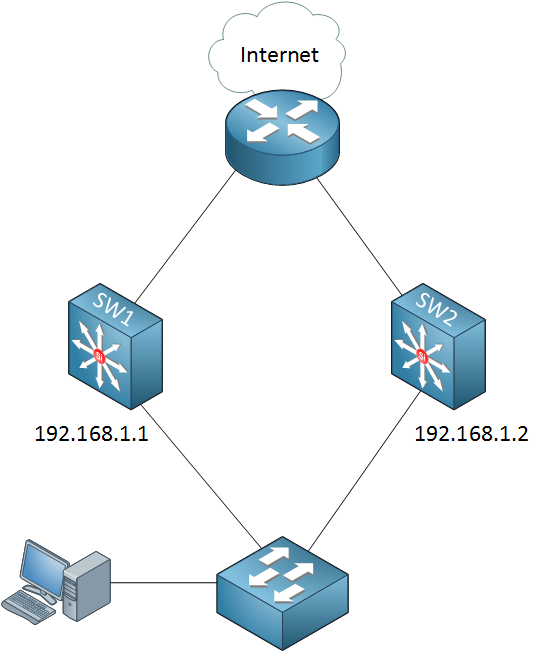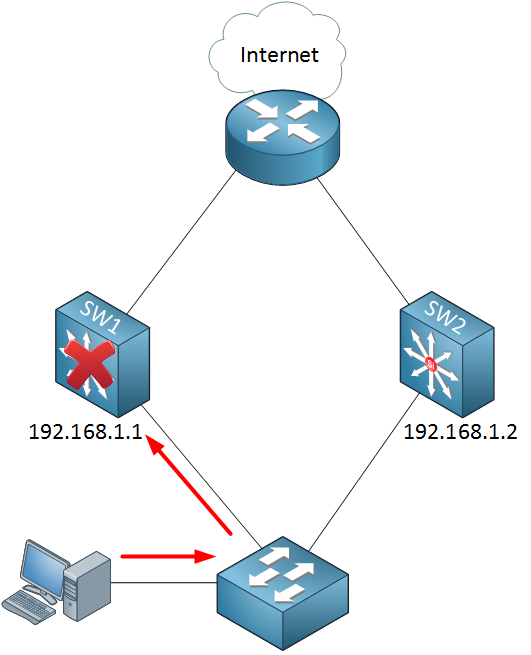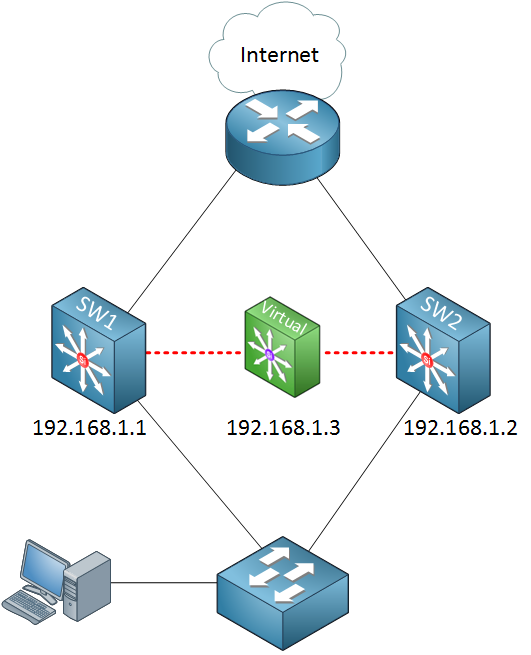In this lesson, we’ll take a look at different protocols for gateway redundancy. So what is gateway redundancy, and why do we need it? Let’s start with an example!

The network in the picture above is relatively simple. I have one computer connected to a switch. In the middle, you’ll find two multilayer switches (SW1 and SW2) that both have an IP address that could be used as the default gateway for the computer. Behind SW1 and SW2, there’s a router that is connected to the Internet.
Which gateway should we configure on the computer? SW1 or SW2? You can only configure one gateway after all…

If we pick SW1 and it crashes, the computer won’t be able to get out of its own subnet because it only knows about one default gateway. To solve this problem, we will create a virtual gateway:

Between SW1 and SW2, we’ll create a virtual gateway with its IP address. In my example, this is 192.168.1.3.
The computer will use 192.168.1.3 as its default gateway. One of the switches will be the active gateway, and in case it fails, the other one will take over.
There are three different protocols that can create a virtual gateway:


Can you run virtual gateway redundancy (HSRP, VRRP, GLBP) over access – to – distribution lines that are running etherchannel as well?
Jason,
This depends on how the access layer connects to the distribution layer. A single Etherchannel is not supported between one physical switch and two different physical switches (unless those two switches using Stackwise, VSS, or vPC). By this, I meaning the following is NOT allowed:
You can, however, have Etherchanel across two links that connect two switches together. So, in the case below
... Continue reading in our forumIf you could choose, which gateway redundancy protocol & version would you choose and why? Personally, It sounds like GLBP is the best because it combines the redundancy that HSRP & VRRP provide, while providing actual load-balancing. Oddly, I’ve read/seen HSRP used much more frequently than GLBP; do you think this is simply because more people are familiar with HSRP/ Cisco pushes it harder or is there a legitimate design reason?
-Bartley
Hello Bartley
Both HSRP and GLBP are Cisco proprietary protocols while VRRP is an IEEE standard. From my experience, VRRP should only be used when configuring gateway redundancy with other vendors’ equipment. Compared to HSRP and GLBP, it has no load balancing capabilities.
When using Cisco IOS devices, HSRP does not support load balancing while GLBP does, as you correctly state. However, for Nexus devices, HSRP does automatically perform load balancing across multiple gateways. So from a functional standpoint, GLBP should be used with IOS devices, and eith
... Continue reading in our forumI have an issue where I have a vlan in 2 DC but the Default gateway for both is in one DC. There is an issue when large amounts of data need to reach DG.I am trying to isolate bot DC so the default gateway for both Vlans is localized and does not traverse the OTV, this giving us 1 DG at one data cents and 1DG and 2DC
DC1
vlan 680
ip add 10.60.81.248/23
hsrp 60
ip 10.60.81.250
Dc2
vlan 680
ip add 10.60.81.249/23
hsrp 68
ip 10.60.81.250